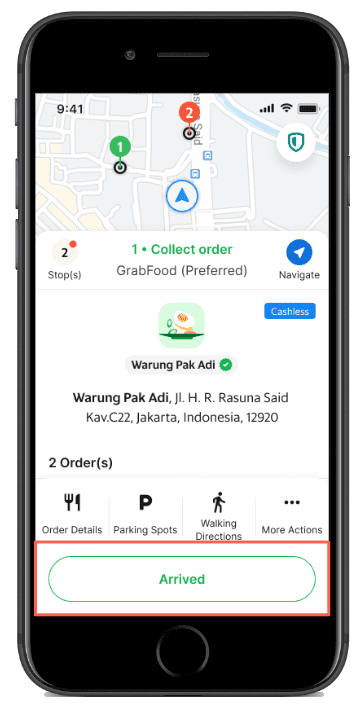When a driver-partner arrives at a food outlet to pick up an order, the Grab Driver app asks them to report their arrival by tapping a button. Once the food is ready and they pick up the order, the app shows a prominent button to confirm that action.
These two steps allow Grab (NASDAQ:GRAB) to measure more accurately how long an order takes to get prepared by a food outlet.
The team sought to further increase the precision of these button press timings, because humans may not always click these exactly on time when they’re busy with picking up and packing delivery orders into their bags.
Grab wants to be precise with timing because our machine learning engine learns to predict a merchant’s food preparation time. Better estimation of the time needed for a dish to be ready helps the system time a delivery partner’s arrival, cutting down on waiting time for the driver-partner. By timing the pick-up, we also minimise any time the food spends waiting to be picked up too, cutting down the wait time for the end-user at home.
This is what led our Geo team to explore placing Bluetooth beacons at merchants’ pick-up areas, to automatically track when a driver-partner arrives.
It starts with a little Bluetooth beacon
In mid-2022, we started a two-month pilot with 35 merchants across three malls in Singapore with high order volumes, as well as two GrabKitchens—cloud kitchens that serve multiple food brands from one spot.
Our team placed these sensors under or by the counter where Grab driver-partners typically pick up food orders from each merchant.
Shuangquan Hou, senior product management leader with Grab’s Geo team, said these unobtrusive little Bluetooth pucks are already widely used in different industries, although the application in food delivery is unique.
“We needed to find a way which is low cost, scalable, and accurate,” he said, explaining that the off-the-shelf hardware is already mass produced and available cheaply. The models Grab used for the pilot have batteries that last for about five years.

Beacons in Southeast Asia
After the first pilot in May 2022, the team worked with McDonald’s Singapore to test the beacons across 30 of its locations in the later part of 2022.
After that, the Geo team deployed over 1,000 beacons in Singapore, and started piloting 100 beacons each in Jakarta (Indonesia), Klang Valley (Malaysia), Manila (the Philippines), Ho Chi Minh City (Vietnam), and Bangkok (Thailand).
We plan to scale this further across Southeast Asia in 2023, and the team is aware of different operational differences across countries.
“There is different behaviour in different countries,” explained Hou. “For example, we see that in Singapore, most driver-partners already have their Bluetooth on. That’s not the case outside Singapore, where we need to remind driver-partners to turn it on.”
Ultimately, the goal remains a smoother experience for users, said Ankush Khandelwal, Head of Analytics for Geo.
It all starts with good data. “You need confidence that the data is accurate, and precisely captures what’s happening,” he said.
3 Media Close,
Singapore 138498
Komsan Chiyadis
GrabFood delivery-partner, Thailand
COVID-19 has dealt an unprecedented blow to the tourism industry, affecting the livelihoods of millions of workers. One of them was Komsan, an assistant chef in a luxury hotel based in the Srinakarin area.
As the number of tourists at the hotel plunged, he decided to sign up as a GrabFood delivery-partner to earn an alternative income. Soon after, the hotel ceased operations.
Komsan has viewed this change through an optimistic lens, calling it the perfect opportunity for him to embark on a fresh journey after his previous job. Aside from GrabFood deliveries, he now also picks up GrabExpress jobs. It can get tiring, having to shuttle between different locations, but Komsan finds it exciting. And mostly, he’s glad to get his income back on track.

